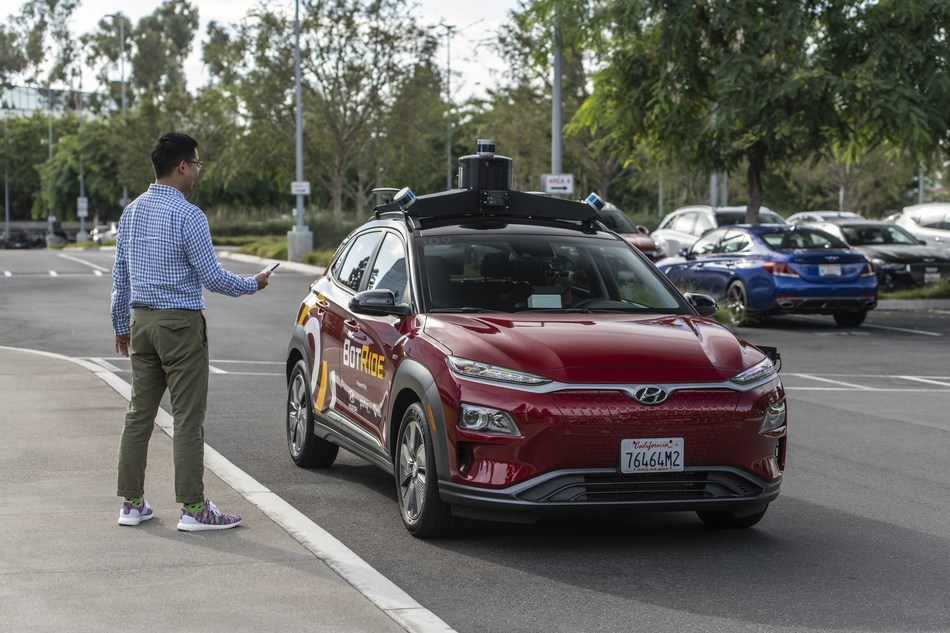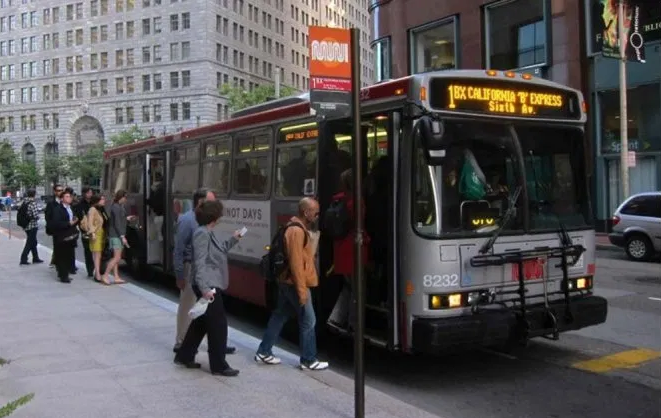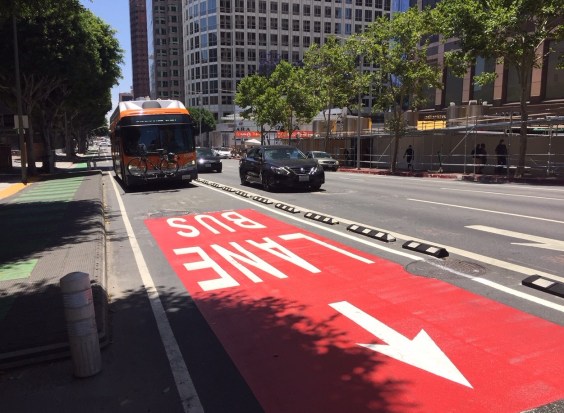California Readying Rules for Automated Vehicle Ride-Hailing
1:40 PM PDT on May 4, 2020

Note: The authors are researchers at the UC Davis Policy Institute for Energy, Environment, and the Economy, referred to throughout as the Policy Institute. The Institute weighed in on state rule-making, as discussed below.
California’s first-ever Autonomous Vehicle (AV) Passenger Service Pilot Program (AV Pilot) is underway. This means that someone near you could potentially be hailing a ride from an automated vehicle rather than a taxi or ride-hail driven by a human being.
But the state is also currently wrestling with how to move the AV Pilot Program to the next phase. It is also considering which rules need to be strengthened or changed to protect public safety, accessibility, and the environment.
The California Public Utilities Commission (CPUC) is in charge of creating regulations for AVs in fleet services (e.g., taxis and ride-hailing). The CPUC is currently managing a dialogue among dozens of parties weighing in on issues such as whether driverless AVs in pilot services should be allowed to collect fares for trips, whether they should be allowed to accept pooled or shared rides, and what types of data they should report. This article explains the CPUC’s jurisdiction over AVs and summarizes perspectives from the chorus of voices (expressed in hundreds of pages of comments) seeking to influence the CPUC’s decisions.
The AV Pilot Program: A Brief Background
Ensuring safe operation of AVs on public roads requires different types of regulation. The California Department of Motor Vehicles (DMV) generally oversees the vehicles that use AV technology. The DMV regulates AV design and issues testing permits that allow on-road testing of AVs and AV technology. The DMV requires AV companies to submit a self-certification that was designed by the National Highway Traffic Safety Administration as a voluntary guidance document.
The CPUC, on the other hand, oversees the companies that seek to use AVs in their businesses. Right now, the greatest demand for AVs for fleets comes from ride-hailing companies like Lyft and Uber. In response to this demand, the CPUC authorized California’s first two ride-hailing AV pilot programs in April 2018. These statewide programs are similar to, but separate from, regional AV pilot programs previously approved (and regulated) by the state legislature, among them a pilot in San Ramon run by the Contra Costa Transportation Authority and one in Dublin, run by the Livermore Amador Transit Authority.
The first of the two state pilot programs allows DMV-approved companies to offer rides in AVs that have a driver present in the car - so-called "drivered AVs." The second pilot program allows AVs without a driver to pick up passengers - “driverless AVs.” Under the rules of the pilot, driverless AVs must have a remote operator in contact with the vehicle and its passengers while a ride is happening.
To date, five authorized carriers— Zoox, AutoX, Pony.ai, Waymo, and Aurora Innovation—have been granted permits to pilot-test AVs with passengers. These permits come with some important conditions. Both of the CPUC’s AV pilot programs require AV ride providers to obtain explicit passenger consent, and they prohibit the companies from collecting any money or other compensation for rides, regardless of whether a driver is present or not. Both pilot programs also require companies to submit trip data to the CPUC on a quarterly basis. Providers of driverless AV rides are also barred from offering pooled rides.
Goodbye Free Pilot — Hello, Paying Passengers!(?)
Now, in its second year of the pilot programs, the CPUC has begun to develop a regulatory framework for transitioning to the next phase, which could be either an expanded pilot or full deployment of passenger-serving AV fleets. In developing the final rules, the CPUC has solicited feedback [PDF] from key stakeholders on a variety of issues, including how to ensure passenger safety, how to incorporate equity and environmental justice into the AV regulatory framework, what data sharing should be required, and how to regulate emissions from AV ride-hail trips.
More than twenty organizations have submitted comments in response to the CPUC’s solicitation. They include:
- Companies: AAA; Aurora Innovation; Cruise; Lyft, Inc.; Uber Advanced Technologies Center, LLC.; Waymo; and Zoox.
- Trade associations: Bay Area Council; California Chamber of Commerce; Hispanic Chambers of Commerce, San Francisco; San Francisco Council of District Merchants Association; San Francisco Taxi Workers Alliance; Silicon Valley Leadership Group; and TechNet.
- Advocacy groups: California Council of the Blind; Greenlining Institute; Sierra Club; and Mothers Against Drunk Driving
- Research outfits: UC Davis Policy Institute for Energy, Environment, and the Economy (Policy Institute)
- Governmental organizations: Los Angeles Department of Transportation; San Francisco Municipal Transportation Agency; and San Francisco County Transportation Authority
Below, we summarize these comments, identifying common themes and outlining rationales for each position. We also describe where opposing positions will require careful evaluation to best preserve the public interest.
Pooling
Many stakeholders, among them the Policy Institute PDF], emphasize the importance of allowing passengers to share or pool rides when using AV ride-hail services. Both commercial and public interests are aligned over the importance of allowing pooling. Many parties note that AVs have the potential to increase demand for rides, which can increase emissions and traffic. This impact can be reduced somewhat by incentivizing pooling. The CPUC restricted pooling in its pilot programs over safety concerns about strangers sharing a vehicle in the absence of a driver. Companies such as Lyft point out that [PDF] strangers routinely share public transportation without direct supervision, such as while aboard trains or light-rail cars. Other stakeholders argue that passenger safety can be maintained through innovations [PDF] like in-app communication between passengers and remote operators, in-cabin video feeds, and emergency call buttons. Los Angeles suggests that AV passenger services provide mechanisms for passengers to stop their vehicle, call for help, and communicate with an operator should any issue with the vehicle or another passenger arise. Several other parties recommend that the CPUC require AV operators to submit safety plans before being authorized to operate AVs fleets.
Environmental
Electrifying AV fleets will be a key strategy in aiding the state's efforts to reduce greenhouse gas emissions. This was emphasized by many commenters, although most parties agree that CPUC should tread cautiously when it comes to imposing additional environmental regulations. The California Air Resources Board (CARB) is already working to reduce emissions from ride-hail companies in compliance with S.B. 1014, by setting a novel standard for measuring and reducing fleet-level GHG emissions. The CPUC would need to align its efforts with CARB’s regulatory process. Some AV development companies are also concerned that imposing environmental regulations early in the AV development process could hamper innovation.
Equity and Environmental Justice
Comments on incorporating equity and environmental justice into AV services were less uniform than comments on pooling or the environment. Several parties, including the Policy Institute, actively support ongoing community engagement to ensure equitability of AV services for all neighborhoods and all riders, calling on the state to prioritize equity. The Greenlining Institute suggests that equity is best advanced at the local level, and points to its Making Equity Real in Mobility Pilots Toolkit as a guide for helping cities ground their AV activities in community engagement. It should be noted that COVID-19 will likely have an initial chilling effect on consumer demand for pooled rides. Extra safety protocols may be needed in shared vehicles, but restricting sharing remains a problematic policy.
Safety
Most parties cite safety as a top priority. They also point out that both the DMV and the NHTSA already have safety regulations in place for AVs and drivers. Most AV development companies, including Aurora, Waymo, Zoox, and Cruise, argue that those regulations are sufficient, and that the CPUC does not need to create additional safety regulations. City agencies, however, generally recommend that safety requirements go further. Los Angeles suggests that operators should have to demonstrate their ability to achieve safety-based outcomes before being allowed to deploy AV passenger services. San Francisco similarly recommends that a permitted applicant be required to demonstrate that they “improve safety for all road users.” The Bay Area’s Metropolitan Transportation Commission emphasizes the importance of studies that monitor safety before and after AV rollout.
Compensation
Most stakeholders believe that AV services should be allowed to collect fees, even in a pilot stage. AV development companies like Aurora argue that it is important for the CPUC (and the industry at large) to understand how passengers interact with AVs in a commercial market - and that can only be accomplished if they are allowed to charge fares. The Policy Institute agrees, and further points to the possibility that cheap or free AV services could encourage excess travel and potentially result in mode shifts away from transit, walking, or biking.
Dissenters include the cities of San Francisco and Los Angeles, both of which caution against allowing compensation without further consideration of passenger and road safety. San Francisco advocates for a slower path from pilot to full deployment, in order to give cities more control over—and time to prepare for—the types and numbers of AVs allowed on their streets. San Francisco reasons that restricting compensation will slow the growth of the AV service industry. Theoretically, slowing the pace of pilots could avoid a repeat of the rapid adoption of ride-hailing or e-scooters, which forced many cities to respond reactively, with little time to plan or adapt to what were major changes.
Accessibility
The CPUC asked commenters to define the term “accessibility.” Some suggest defining accessibility narrowly, with direct reference to disability rights. The MTC suggests that a definition of AV accessibility should align with the CPUC’s efforts regarding S.B. 1376, a recent legislative mandate to increase wheelchair-accessible vehicles. Others, including the Policy Institute, advocate a broader view. The Policy Institute suggests defining accessibility as a metric for quantifying opportunity: e.g., access to jobs or healthcare. The Greenlining Institute further suggests that the CPUC address a broader range of accessibility needs, including financial, cultural, technological, and logistical access, as well as race, gender, age, class, and location.
Data Sharing
The AV Pilot represents the tip of the data-collection iceberg. Both CPUC and CARB require data reporting from ride-hail companies, and both agencies are also wrestling with how to update reporting requirements to meet state climate, labor, and equity goals. In March, the CPUC announced that it will make annual ride-hail reports public. Those reports had been - but will no longer be - considered confidential a priori, although companies can make formal requests that all or part of their report remain confidential. The extent to which this decision will apply to AV Pilot participants remains unclear.
The CPUC’s recent decision appears to align with comments from the public sector, which adamantly support increased transparency surrounding ride-hail data. Some cities and agencies would like to increase the frequency of data reporting from annually to quarterly. Many also suggest replacing zip-code-level reporting requirements with more granular census-tract-level requirements, or even more granular GPS data. Companies push back on expanding data reports, citing concerns about customer privacy as well as fears that excessive data sharing could stifle innovation and competition. The Silicon Valley Leadership Group and TechNet express doubts that public agencies have the capacity to protect data they collect and worry that granular data can be disaggregated and de-anonymized, putting passenger safety at risk.
The Policy Institute seeks a middle ground in which sharing of granular data is permitted only if it serves a clear public objective. The Policy Institute also suggests that data be managed by a third party, available only to qualified analysts. (For more on these topics, see Mobility Data Sharing: Challenges and Policy Recommendations from the Policy Institute, and the UC Institute of Transportation Studies Innovative Mobility Initiative’s Sharing Mobility Data for Planning and Policy Research.
Next Steps for the AV Pilot
At some time in the near future, maybe tomorrow, maybe next month, the CPUC will issue what’s called a “Proposed Decision” to take the next steps for the passenger service AV pilot program. This will open another thirty-day comment period, which will allow all parties to submit additional comments. After this comment period closes, the CPUC will issue a decision. It is unclear whether the final decision will be small tweaks to the existing pilot, or whether it will establish a pathway towards a more comprehensive AV service deployment program. But, either way, the decision will mark a turning point that will advance the AV revolution in California.
Streetsblog California editor Melanie Curry has been thinking about transportation, and how to improve conditions for bicyclists, ever since commuting to school by bike long before bike lanes were a thing. She was Managing Editor at the East Bay Express, editor of Access Magazine for the University of California Transportation Center, and earned her Masters in City Planning from UC Berkeley.
Read More:
Stay in touch
Sign up for our free newsletter
More from Streetsblog California
Thursday’s Headlines
LA Metro declares emergency over attacks on bus operators; Some deadly Bay Area streets to see safety fixes; Tax ride-hail to save transit? More
Bill to Require Speed Control in Vehicles Goes Limp
Also passed yesterday were the Complete Streets bill, a bill on Bay Area transit funding, and a prohibition on state funding for Class III bikeways.
‘We Don’t Need These Highways’: Author Megan Kimble on Texas’ Ongoing Freeway Fights
...and what they have to teach other communities across America.
Wednesday’s Headlines
Brightline LA-to-Vegas promises quick construction; LA Metro buses set to test camera enforcement of bus lane obstruction; Why are we still knocking down houses to build freeways? More
Brightline West Breaks Ground on Vegas to SoCal High-Speed Rail
Brightline West will be a 218-mile 186-mile-per-hour rail line from Vegas to Rancho Cucamonga - about 40 miles east of downtown L.A. - expected to open in 2028




